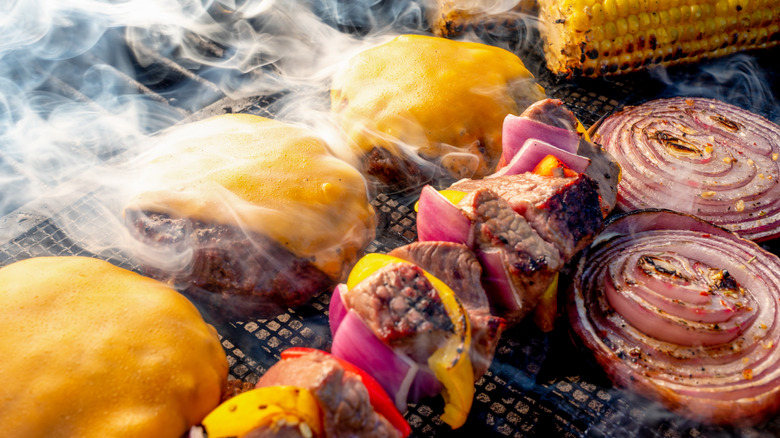Turn Your Backyard Grill Into A Smoker With One Charcoal Trick
The real world can be a harsh place, and adulting can mean leaving childish things behind ... at least for up to (and sometimes beyond) eight hours a day. The good news is that you definitely don't have to leave a childhood love of magic behind, because we have one barbecue trick that's better than any bit of magic your 7-year-old self struggled to understand and replicate. What is it? Turning your charcoal grill into a barbecue smoker.
While turning your gas grill into a smoker is almost shockingly easy, doing the same with a charcoal grill is admittedly a little more complicated. Still, once you try it and master the art of it, it'll open up a whole new grilling experience for you — without the need to invest in a separate smoker. Seriously, who has room for that?
There's no fancy equipment needed, either, just the same charcoal you'd already have on hand, a disposable aluminum pan, and some of the same wood you'd use in a smoker. If it sounds too good to be true, don't worry, it isn't: With just a little patience and some ingenuity, you can turn that backyard grill into a legit smoker. Sunny summer afternoons might never be the same, now that you'll be able to kick back and smoke some delicious meats!
Set up your grill using the snake method
Setting your charcoal grill up to be a smoker correctly is the key to success. Fortunately, we can quickly and easily tell you how to do it, starting with a disposable aluminum tray. Have that ready to place in the middle of the grill (on the same level as the charcoal), and filled most of the way with water. Then, it's all about positioning your charcoal.
It's possible that's the most time-consuming part (aside from the smoking itself). Line the outer rim of the grill with charcoal bricks, standing on-end and resting on each other. Don't go all the way around — leave at least a six-inch gap so the charcoal forms a C (as pictured). Place another row of charcoal inside that, and for a longer burn you can add another on top for a total of three rows that form a pyramid. Then, take your flavored wood and place it between the grill's side and the top row of charcoal. Make sure the vents on the grill are open, as airflow is going to be crucial to maintaining the temperature that's going to cook your meat low and slow.
Then, get the fire going. The easiest way to do that is to start some charcoal burning in a chimney starter, and once that's going, dump it over one end of your snake. That'll light those pieces of charcoal, which will in turn start to slowly burn through the whole thing. That's it!
Here's what you need to know about adjusting the temperature
Depending on the size of the grill — and the length of your charcoal snake — you'll be able to maintain a consistent temperature of between 250 to 300 degrees Fahrenheit for anywhere from 6 to 14 hours. If you're having trouble keeping the temperature in that range, there are a few things that you can do.
For starters, make sure that the lid of the grill is in a position where the vent is opposite the starting end of the snake, and move as necessary — that will help keep the air flowing, which is crucial to making this work. If your grill smoker isn't getting up to temperature, close the vents more: The upper vent should, however, never be closed completely, as this is what's allowing the smoke to escape. (Without proper venting, it could leave your meat with a funky charred taste instead of a smoked one — it's one of the most common mistakes people make when smoking meat.)
You can also adjust the lower vents as needed, but there's an important caveat to this. Small changes will have a big impact on the temperature inside your grill, but it'll take time to be reflected in the interior environment. Make small adjustments, and as you're monitoring with a smoker thermometer, make sure you're giving things enough time to equalize before making more changes.
Here's how to get the most out of your grill smoker
Now, let's talk about the best options for smoking using this method. Some meats — like chuck roast and beef brisket — can take up to 20 hours to finish smoking, so they're probably not the best thing to attempt here. There are, however, plenty of other options.
Any kind of poultry is going to come out amazing, with even a whole turkey taking somewhere between three and five hours — well within the length of time that your snake is going to burn. There's plenty of choices for beef lovers, too, with back and spare ribs taking between three and four hours, while prime rib and ribeyes can be done in under half an hour. Also great? Sausage of almost any kind, as it'll smoke within about an hour. That makes it perfect for not only doing by itself, but alongside other meats that smoke fairly quickly. That includes fish, most of which will be done in about an hour. Pro tip: Smoke the sausages for meals throughout the week, and the fish for a fresh dinner.
Lamb shanks, shoulders, and legs are going to take as long as six to eight hours, though, so reserving this one for larger grills is probably to be recommended. (All cooking times are estimates: Always check your meat with a thermometer before eating.)



